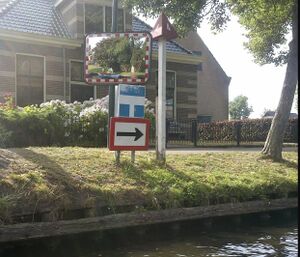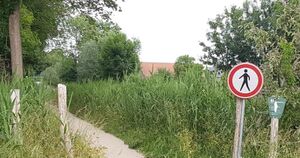NL:Key:oneway
 |
| Omschrijving |
|---|
| Straten met éénrichtingsverkeer |
| Groep: restrictions |
| Gebruikt op deze elementen |
| Gedocumenteerde waarden: 5 |
| Nuttige combinaties |
|
| Status: de facto |
| Gereedschappen voor deze tag |

De oneway key wordt gebruikt op wegen en andere lineaire OSM-elementen om aan te geven dat voertuigen maar in één richting mogen gaan. Let erop dat een verkeersbord dat toegang vanaf één kant van de weg of op één punt op de weg niet automatisch betekent dat de weg voor éénrichtingsverkeer bedoeld is (let ook op andere verkeersborden of wegmarkeringen op of langs de weg).
Zie ook de NL:Key:access-pagina voor een uitgebreidere beschrijving van toegangsrestricties.
In kaart brengen
Basaal gebruik
Om een weg (of ander lineair object) als éénrichtingsweg te markeren, voeg de volgende tags toe:
De oneway tag is gerelateerd aan de tekenrichting van een lineair OSM-element ("way"): oneway=yes betekent dat voertuigverkeer alleen in de tekenrichting toegestaan is. Identifying the direction of a way beschrijft hoe je de richting van een way kunt bepalen in de belangrijkste OpenStreetMap editors.
Als de oneway restrictie in de omgekeerde richting van de getekende weg geldt is het raadzaam om de weg om te keren ("reverse way" in de editors) en dan oneway=yes toe te voegen. In de zeldzame gevallen waarin dit niet mogelijk is, kun je in plaats daarvan oneway=-1 toevoegen. Let op: als de eenrichtingsweg onderdeel uitmaakt van een fietsrouterelatie, moet vaak bij het omkeren de relatie aangepast worden.
Als de weg alleen éénrichtingsverkeer heeft in bepaalde delen, moet je de weg splitsen in stukken en de oneway tag toevoegen aan de relevante wegdelen.
Geïmpliceerde oneway restricties
Sommige tags of tagcombinaties (zoals junction=roundabout, highway=motorway en mogelijk andere) impliceren per definitie oneway=yes (Aparte rijbanen voor de rijrichtingen zijn onderdeel van de definiërende kenmerken voor "motorways" in de Vienna Convention on Road Traffic) en daarom is deze tag hierbij optioneel.
Als de wiki-pagina van een andere tag dan deze twee vermeldt dat hij "oneway=yes" impliceert, let dan goed op want dit is niet altijd per definitie waar voor alle landen. Buiten de genoemde twee tags is er geen algehele overeenstemming over welke tags oneway=yes impliceren. Verschillende toepassingen kunnen dit naar eigen inzicht behandelen, daarom wordt aanbevolen om eenrichtingsverkeer in die gevallen expliciet te taggen.
Een voorbeeld: in Nederland zijn fietspaden langs verbindingswegen wettelijk eenrichtingspaden, tenzij op de weg anders aangegeven. Internationaal is het gebruikelijk dat zulke fietspaden tweerichtingsverkeer zijn, en moet juist eenrichtingsverkeer apart worden aangegeven. Het is daarom aan te bevelen om hier expliciet te taggen dat ze éénrichting zijn, zodat data users niet de Nederlandse wet als uitzondering hoeven te kennen.
oneway = no
oneway=no wordt gebruikt om duidelijk aan te geven dat een (deel van een) straat geen éénrichtingsweg is. Gebruik deze tag alleen om te voorkomen dat fouten ontstaan, zoals op plekken waar veel éénrichtingsverkeer is of om standaardwaarden te overschrijven.
Valse eenrichtingswegen (Faux oneway)
Valse eenrichtingswegen (German: Unechte Einbahnstraßen) zijn tweerichtingstraten die alleen aan één kant een inrijverbod hebben. Er staan verder geen eenrichtingborden. Sommige landen gebruiken dit als concept.
Dit kan op twee manieren gemapt worden:
- Splits een kort stukje (ca 1 m) van de straat af bij het inrijverbod, en tag het met
oneway=yes. (Prefered by some, but perhaps less accurate since it is not a true oneway street). - Gebruik een restriction relation op de plaats van het inrijverbod. De hoofdtag van de relatie is dan
restriction=no_entry, en uitzonderingen kunnen gemaot worden metexcept=*(bijvoorbeeld voor fietsen, bussen etc.)
Verwante tags en uitzonderingen
De prefix "oneway:" kan worden gecombineerd met voertuigtype om uitzonderingen te taggen. Bijvoorbeeld oneway:moped=no voor een eenrichtingsweg waar bromfietsen in de tegenrichting mogen rijden, of oneway:bicycle=no voor fietsen. Gebruik cycleway:left=* / cycleway:right=* / cycleway:both=* om fietsinfrastructuur aan te geven; zie Bicycle voor voorbeelden. Zie Key:access voor meer voorbeelden.
Tijdgebonden eenrichtingsverkeer
Als een weg op bepaalde tijden niet toegankelijk is in de ene richting, en op andere tijden in de andere richting, dan kun je dat taggen met oneway=reversible samen met de van toepassinge zijnde conditional restrictions. Als de richting erg vaak verandert, kan oneway=alternating van toepassing zijn.
Op waterwegen

Eenrichtingsverkeer voor boten op waterways kan ook met oneway= worden gemapt, bijvoorbeeld als er een seamark staat of er een wettelijke regel geldt. Gebruik oneway=* niet voor de stroomrichting op waterwegen waar de stroom verschillende kanten op kan gaan, want oneway=* geeft de wettelijke vaarrichting, niet de stroomrichting.
De stroomrichting wordt gegeven door de tekenrichting van de waterway in OSM. Als de waterstroom op waterwegen en in pijpleidingen ook de andere kant op kan gaan, wordt wel flow_direction=both gebruikt.
Data consumers
Aanbevolen waarden
oneway=yes(ontraden alternatieven: "true", "1")oneway=no(ontraden alternatieven: "false", "0")oneway=-1(ontraden alternatieven: "reverse")oneway=reversible- Voor wegen die geregeld maar niet voortdurend van richting wisselen (bijvoorbeeld wisselstroken voor spitsverkeer). Kan worden gecombineerd met conditional restrictions.oneway=alternating- Voor wegen die te vaak of te onregelmatig van richting wisselen.
De betekenis van andere waarden is niet gedefinieerd; het gebruik van andere waarden wordt afgeraden.
NB: De waarde -1 is alleen nodig als het eenrichtingverkeer tegen de tekenrichting ingaat. Dit kan vermeden worden door de tekenrichting van de weg eerst om te keren. Let dan wel op eventuele routerelaties waar de weg een lid van is. Check deze en pas zonodig ook de relatie aan.
Interpretatie voor routeren
Oneway tags kunnen voor routeren als volgt worden vertaald naar het algemene systeem:
Voetgangers

highway=path + oneway=yes + foot=yes + bicycle=no + ski=no + snowmobile=noAls gegeven wordt aangenomen dat eenrichtingsbeperkingen niet voor voetgangers gelden. Dit volgt de betekenis van gebruikelijke eenrichtingsborden zoals C, 1a in de Vienna Convention on Road Signs and Signals ("toegang is verboden voor alle voertuigen").
Op een formele highway=footway (met een "footway" bord zoals D, 5 wat ander verkeer uitsluit) kunnen onderborden staan met uitzonderingen voor bijvoorbeeld fietsen of aanwonenden. Ook in die gevallen is oneway=* niet van toepassing op voetgangers maar alleen op voertuigen.
Hoewel ongebruikelijk, is het in sommige landen mogelijk dat voetpaden (path, footway, track) eenrichtingverkeer voor de voetgangers hebben. Dit wordt soms aangegeven met oneway:foot=*, maar dat is omstreden; anderen gebruiken liever foot:backward=no.
Het gebruik van highway=footway + oneway=no om aan te geven dat voetgangers maar in 1 richtng mogen, wordt als fout beschouwd, omdat oneway=* alleen op voertuigen van toepassing is. Op een path of track mogen meestal ook voertuigen, zodat oneway=yes daar niet kan worden gebruikt om eenrichtingsverkeer voor voetgangers aan te geven.
Het bestaande gebruik in de OSM database houdt zich niet helemaal aan deze richtlijnen. Bijvoorbeeld, eind 2021 lieten tellingen van highway=path + oneway=*, oneway:foot=yes en foot:backward=no zien dat sommige mappers oneway=* geldig vinden van alle voortbewegingen, ook te voet. Aan de andere kant wordt oneway=yes massaal gebruikt voor eenrichtingswegen waarop voetgangers in beide richtingen mogen.
Datagebruikers zouden misschien in principe het alleen-voertuigen-concept kunnen volgen maar eventueel daarvan afwijken als de tag oneway:foot=* aanwezig is, en als oneway=* gezet is op een footway. Maar het is natuurlijk aan de datagebruikers om tags te interpreteren zoals zij dat passend vinden.

Eenrichting voor voetgangers komt voor op sommige trekkerspaden - sommige permanent, sommige alleen in het hoogseizoen; op grensovergangen, alleen-uit paden, en nog enkele gevallen. Het is ook tijdelijk gebruikt als maatregel om afstand te houden tijdens de Covid19 corona-epidemie.
Landspecifieke implicaties
The following table lists country-specific information needed for correct interpretation of oneway tags.
| Country | Country-specific implications of oneway tags |
|---|---|
| Nederland | Eenrichtingsborden zijn van toepassing op "voertuigen, ruiters en geleiders van rij- of trekdieren of vee".[1] In OSM betekent dat dat oneway=yes niet alleen vehicle:backward=no impliceert, maar ook horse:backward=no. Met oneway:horse=no kan dan zonodig worden aangegeven dat paarden wél twee kanten op mogen.
|
| Verenigd Koninkrijk | Eenrichtngsborden zijn ook van toepassing op ruiters.[2] In OSM betekent dat dat oneway=yes niet alleen vehicle:backward=no impliceert, maar ook horse:backward=no. Met oneway:horse=no kan dan zonodig worden aangegeven dat paarden wél twee kanten op mogen.
|
Mogelijke fouten
gebruik geen access-tags om uitzonderingen aan te geven op oneway-tags. Uitzonderingen op oneway-tags worden aangegeven met andere oneway-tags. bijvoorbeeld:
Uitgefaseerde tags
Zie ook
access=*- General access restriction key.- Set of tags that imply oneway=yes according to iD editor
- Pull request to consider implied onewayness in Default Map Style
foot:backward=noconsistent oneway restriction for pedestriansoneway:foot=*- disputed oneway restriction that apply to pedestrians